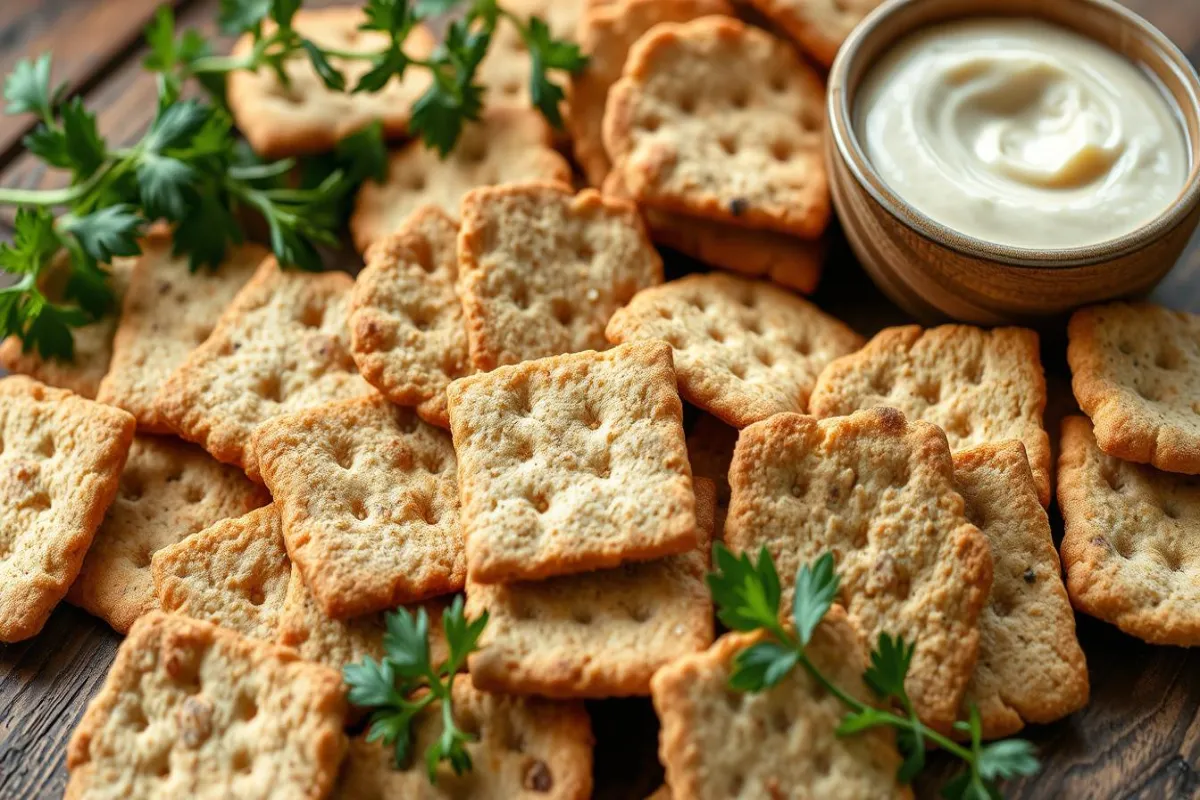I’m always looking for gluten-free snacks that taste great. Saltine crackers are a favorite, but are they gluten-free? Let’s find out.
Saltine crackers are loved by many, but they’re not safe for everyone. If you have celiac disease or gluten sensitivity, they might not be good for you. But, there are now non-gluten options available. Let’s look at these choices together.
Introduction to Saltine Crackers
Saltine crackers are a favorite snack in many American homes. They are known for their crisp texture and salty taste. This makes them great for quick snacks or as a side for soups and dips.
What are Saltine Crackers?
Saltine crackers are thin, square crackers made from wheat flour, water, yeast, and salt. They are baked until they are light and slightly browned. This gives them a crunchy texture and a salty flavor.
The History of Saltine Crackers
Saltine crackers started in the late 19th century as a simple snack. They have remained popular over the years. Today, they are a top choice for those looking for no gluten cracker options or a quick snack.
“Saltine crackers are a classic American snack that have stood the test of time, offering a satisfying crunch and a salty flavor that is hard to resist.”

Understanding Gluten
Gluten is a protein found in grains like wheat, barley, and rye. For people with celiac disease or gluten sensitivity, eating gluten can cause health problems. It’s important to know how gluten affects our diet.
Celiac disease is when the body attacks the small intestine due to gluten. This can cause digestive issues, nutrient shortages, and damage to the small intestine. Gluten sensitivity, however, leads to symptoms like bloating and diarrhea without the autoimmune attack seen in celiac disease.
Many foods, like crackers and bread, contain gluten. People with celiac disease or gluten sensitivity need to check food labels. They should avoid products with wheat, barley, or rye. Choosing gluten-free options can help manage symptoms and prevent health issues.
- Gluten is a protein found in certain grains, such as wheat, barley, and rye.
- Celiac disease is an autoimmune disorder where the body attacks the small intestine when gluten is consumed.
- Non-celiac gluten sensitivity is a condition where individuals experience unpleasant reactions to gluten without the autoimmune component.
- Gluten is a common ingredient in many processed foods, including crackers, breads, and baked goods.
- Individuals with celiac disease or gluten sensitivity must carefully read food labels and avoid products containing wheat, barley, or rye.
Knowing about gluten is key for those with celiac disease or gluten sensitivity. Being aware of the risks and finding gluten-free foods helps manage their condition. This way, they can keep their diet healthy and balanced.

Are any saltine crackers gluten-free?
Traditional saltine cracker ingredients
Most saltine crackers sold today are not gluten-free. They usually have wheat flour as the main ingredient. This is because wheat flour is key to their light, crispy texture.
The ingredients in traditional saltine crackers are:
- Wheat flour
- Water
- Salt
- Baking soda
- Shortening or oil
Wheat flour gives them their crispiness. The other ingredients add flavor and texture. But, this mix makes them not good for those who can’t eat gluten.
People with gluten issues or celiac disease face a big challenge. But, there are gluten-free cracker options out there. We’ll look at them in the next section.
Gluten-free Cracker Options
For those with celiac disease or gluten sensitivity, finding good crackers can be hard. But, the gluten-free market has grown a lot. Now, there are many tasty and healthy crackers for those with dietary needs.
Popular Gluten-free Cracker Brands
Here are some top gluten-free cracker brands:
- Mary’s Gone Crackers: These organic, non-GMO crackers are made from whole grains like brown rice, quinoa, and millet. They offer a crunchy texture and a rich, nutty taste.
- Glutino: Glutino has a wide range of gluten-free products. They offer saltine-style crackers, cheese crackers, and even graham-style crackers.
- Crunchmaster: Made from whole grains, sesame seeds, and flax, Crunchmaster crackers are a crunchy alternative to traditional saltines.
- Nut Thins: From Blue Diamond, these crackers are made from nuts, rice, and seeds. They have a delightful crunch and a subtle, nutty flavor.
| Brand | Key Ingredients | Texture | Flavor |
|---|---|---|---|
| Mary’s Gone Crackers | Organic whole grains | Crunchy | Nutty |
| Glutino | Gluten-free flour blend | Crisp | Versatile |
| Crunchmaster | Whole grains, seeds | Crunchy | Subtly nutty |
| Nut Thins | Nuts, rice, seeds | Crispy | Nutty |
These gluten-free crackers are not just for satisfying your crunch craving. They are also a healthier choice than traditional saltines. They are perfect for those looking for gluten-free cracker options or healthy saltine alternatives.
Celiac Disease and Crackers
For those with celiac disease, gluten in regular crackers is a big problem. Celiac disease is an autoimmune disorder. It happens when gluten, found in wheat, barley, and rye, damages the small intestine. This can cause symptoms like stomach pain, bloating, and malnutrition.
People with celiac disease must follow a strict gluten-free diet. This means avoiding all gluten products, including regular crackers. Finding gluten-free cracker alternatives is key for their health.
The Importance of Gluten-free Crackers for Celiac Patients
Gluten in crackers can harm those with celiac disease a lot. The immune system’s reaction to gluten damages the small intestine. This can lead to malabsorption of nutrients, causing health problems like anemia and osteoporosis.
Choosing gluten-free crackers is a safe snack option for celiac patients. These crackers are made with flours like rice, corn, or tapioca. They don’t have the harmful gluten protein.
| Celiac Disease | Gluten-free Crackers |
|---|---|
| Autoimmune disorder triggered by gluten | Made with alternative flours like rice, corn, or tapioca |
| Damages the small intestine | Safe for individuals with celiac disease |
| Leads to malabsorption of nutrients | Provide a tasty and convenient snack option |
| Increased risk of health issues | Help maintain a healthy, gluten-free diet |
Understanding the link between celiac disease and crackers helps those with it make better choices. Looking for gluten-free crackers is a big step in managing celiac disease. It helps keep their diet balanced and nutritious.
Gluten Sensitivity and Snacks
For those with gluten sensitivity, finding good snacks is hard. The snack aisle is full of products claiming to be gluten-free. But, it’s important to know which ones are really safe.
Identifying Gluten-free Snack Options
Look for snacks labeled as “gluten-free” to avoid gluten. This means they don’t have wheat, barley, rye, or other grains with gluten. Also, watch out for cross-contamination during making, which can add gluten to gluten-free products.
Check the ingredients list carefully. Avoid snacks with wheat flour, malt, or gluten. Choose snacks made with rice, corn, or almond flour instead. These are safer and just as tasty as regular snacks.
| Gluten-free Snack Options | Nutritional Benefits |
|---|---|
| Roasted Chickpea Snacks | High in protein, fiber, and various vitamins and minerals |
| Veggie Straws or Chips | Made from vegetables, often low in calories and high in nutrients |
| Nut-based Crackers | Provide healthy fats, protein, and a satisfying crunch |
Learning about gluten-free snacks can make snacking easier. With some effort and attention to labels, you can find great gluten-free snacks. This way, you can enjoy tasty and healthy options that fit your diet.
Healthy Saltine Alternatives
Exploring gluten-free crackers is key to finding healthy saltine options. These alternatives are great for those with dietary needs and offer a tasty snack for everyone. Let’s look at some wholesome, gluten-free crackers that are good for you and taste great.
Nutritious Gluten-free Crackers
Gluten-free crackers are a smart choice for healthy alternatives. They’re made without wheat, rye, or barley, perfect for those with gluten issues. Here are some top brands:
- Mary’s Gone Crackers – These organic, non-GMO crackers use whole grains like brown rice, quinoa, and amaranth for extra nutrition.
- Crunchmaster – With many flavors, Crunchmaster crackers mix brown rice, sesame seeds, and other healthy ingredients.
- Simple Mills – Their almond flour-based crackers are crunchy and satisfying, with a simple ingredient list.
These gluten-free crackers are not just for dietary needs. They’re also packed with fiber, protein, and vitamins, making them a better choice than regular saltine crackers.
“Embracing healthy saltine alternatives empowers us to nourish our bodies without sacrificing the snacking experience.”
Trying these nutritious no gluten crackers can help you enjoy snacks while keeping your health in mind. Whether you’re gluten-free or just looking for a healthier snack, these options are tasty and guilt-free.
Reading Ingredient Labels
Exploring crackers, especially gluten-free ones, can seem tough. But, learning to read labels is key to making smart choices. By understanding what’s in your crackers, you can pick safe, gluten-free options that fit your diet.
Deciphering Cracker Ingredients
Start by checking the ingredient list for gluten. Look out for wheat, barley, rye, and oats. These are no-go’s for a gluten-free diet. Instead, look for crackers made with rice, corn, or nuts.
Also, think about how the crackers are made. Even gluten-free crackers might be made in places that handle gluten. Always choose crackers labeled as “gluten-free” to be sure they’re safe.
| Gluten-Containing Ingredients to Avoid | Gluten-Free Ingredient Alternatives |
|---|---|
| Wheat, Barley, Rye, Oats | Rice, Corn, Nut-based Flours |
| Soy Sauce (containing wheat) | Tamari (gluten-free soy sauce) |
| Breadcrumbs | Gluten-free breadcrumbs or crumbs |
Knowing the gluten ingredients and their no gluten substitutes helps you shop with confidence. You can find crackers that meet your dietary needs easily.
“Reading ingredient labels is crucial for individuals with gluten sensitivities or celiac disease. It’s the best way to ensure you’re making safe and informed choices when it comes to crackers and other snacks.”
Gluten-free Cracker Recipes
Looking for healthy saltine alternatives or no gluten crackers? Making your own can be a tasty and rewarding choice. You get to control the ingredients and keep your snack healthy.
One favorite recipe mixes almond flour, tapioca flour, and flaxseed meal. This makes a crisp, tasty cracker perfect for snacks or with dips. Another option is a savory herb cracker. It’s made with quinoa flour and seasoned with rosemary and thyme.
Homemade Gluten-free Crackers: A Step-by-Step Guide
- Begin by picking your no gluten flour, like almond, tapioca, or quinoa.
- Add seasonings, herbs, or spices to boost the flavor.
- Mix the dry ingredients in a bowl. Then, add a binding agent, like egg or flax “egg”.
- Knead the dough and roll it out to the right thickness.
- Cut the dough into shapes with a knife or cookie cutter. Place them on a baking sheet.
- Bake the crackers at a moderate temperature until they’re golden and crisp.
- Let the crackers cool completely before enjoying your homemade snack.
Making your own no gluten crackers is a healthier, more personal choice. Try different flour blends and flavors to find your favorite.
“Homemade gluten-free crackers are a game-changer for those seeking a tasty and nutritious snack option.”
Tips for Gluten-free Living
Living with celiac disease or gluten sensitivity can be tough. But, with the right tips, it gets easier. Always check the labels on crackers and choose brands you trust. This way, you can enjoy snacks safely.
Shopping for food can seem hard at first. But, you’ll get better at finding wheat-free options. Keep a list of your favorite snacks and ask for help at the store. Eating out can also be tricky, but many places know how to help. Just ask about your meal and tell your server what you need.
Dealing with social events can be tricky. But, with some planning and confidence, you can stick to your gluten-free diet. Bring a safe dish to share or say no to things you’re not sure about. Your health is most important, and those who care about you will support your choices.
FAQ
Are any saltine crackers gluten-free?
Most traditional saltine crackers have gluten and aren’t good for a gluten-free diet. They’re made with wheat flour, which has gluten. But, there are no gluten crackers you can use instead.
What are the traditional ingredients in saltine crackers?
Saltine crackers are made from wheat flour, water, yeast, salt, and sometimes extra flavorings. The wheat flour is the main source of gluten. This makes them bad for people with celiac disease or gluten sensitivity.
What are some popular no gluten cracker brands?
Brands like Glutino, Crunchmaster, Mary’s Gone Crackers, and Nut Thins offer no gluten crackers. They use flours like rice, almond, or tapioca to make their crackers.
How can I identify no gluten snack options?
To find no gluten snacks, read the labels carefully. Look for “no gluten” labels or products without wheat, barley, or rye. Be careful of hidden gluten in ingredients like modified food starch or malt flavoring. Choose snacks with simple, clear ingredients.
What are some nutritious no gluten cracker alternatives?
Besides popular brands, there are healthier options. Almond flour crackers, seed-based crackers, and whole-grain no gluten crackers are good. They offer fiber, protein, and other nutrients.
How can I make my own no gluten crackers at home?
Making your own crackers at home is a good idea. You can find many recipes online using free of gluten flours like almond or coconut. This way, you can control the ingrediens and flavors to fit your diet.

